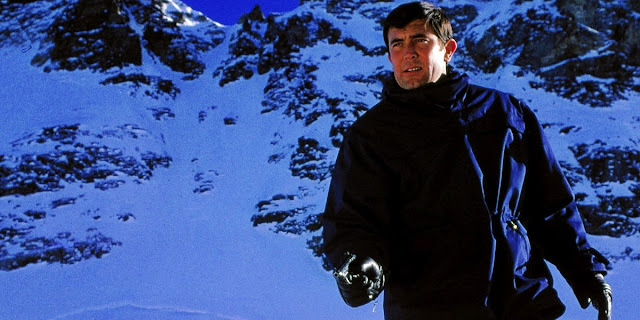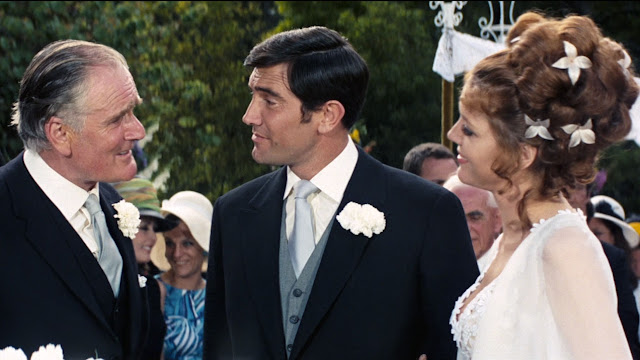On Her Majesty’s Secret Service Review
“Merry Christmas 007”, haunts Blofeld menacingly, laughing as Bond awakens from a blow to the head in a clinical-research institute in the Swiss Alps that acts as a front for Blofeld’s lair in the classic Bond film On Her Majesty’s Secret Service (1969). Bond does his best to keep his cover intact playing the role of a mild-mannered professor on assignment but even Blofeld muses, “It takes more than a few props to turn 007 into a herald”, as he snaps shut Bond’s lenses. On Her Majesty’s Secret Service is an underrated classic Bond picture that stars George Lazenby in his one and only performance as 007. The story follows Bond as he entertains a tragic romance with a mob boss’s daughter played by the timeless Diana Rigg and works to uncover the truth behind Blofeld’s plot in the Alps involving an assortment of beautiful women from around the world. Following Connery’s initial departure from the role, Lazenby fills in quite nicely as a very human Bond who charters dangerous and unchartered waters in this grounded and classic mystery romance.
After 5 films Connery walked away from the role of Bond post-You Only Live Twice (1967), only to return twice more as it would turn out but before then without Connery in the starring role a void was left as production ramped up for the 6th entry in the iconic franchise, On Her Majesty’s Secret Service based on Ian Fleming’s novel of the same name. Peter Hunt who had worked on previous Bond films was promoted to the role of director for this next installment after impressing the Bond producers with his quick cutting style in his role as editor on Thunderball (1965), which they believed had set the style for the series. Hunt approached the film with the intention of making it his own:
"I wanted it to be different than any other Bond film would be. It was my film, not anyone else's."
Richard Malbaum was brought on to pen the script with the understanding that Hunt and the Bond producers were executing a vision of the film that saw it sticking as closely to the original novel as possible. Hunt was striving for realism in the picture which saw him in a move making the decision not to shoot on film sets but rather film everything on location as much as possible.
The bigger question still remained though and that was who would replace Sean Connery as Connery had become highly associated with the character of Bond in the audience’s minds by that point in the late 60s. Roger Moore was originally considered for the role when the Bond producers were looking to adapt The Man with the Golden Gun before that was scrapped at that time due to political instability in the region they were planning to shoot in and by that time Moore had signed up for another series of The Saint. A multitude of other actors were considered for the role including Micheal Caine and future Bond actor Timothy Dalton himself who turned down the role, the young Shakespearean actor feeling that he was too young for the role at the time at the age of 23 as he felt that Bond should be more around 35, 40. However, eventually, the Bond producers settled on Australian actor George Lazenby who landed the role in a truly James Bond fashion. A relatively unknown model hearing that they were looking for the next James Bond, Lazenby, eager to get the job went out and got Sean Connery’s haircut, one of his old suits, and a Rolex watch and proceeded to approach the Bond producers at their offices. Blasting past the secretary he entered the office of Harry Saltzman, leaning on the door quipping:
“I heard you’re looking for James Bond.”
Saltzman wanted to know where Lazenby had acted before noting he had never heard of him before and he told him he had acted in Germany, Russia, Czechoslovakia, Hong Kong, and a whole host of other countries he thought the Bond producers couldn’t check up on. This was of course before the days of the Internet. Impressed Harry Saltzman brought Lazenby into the fold, Lazenby quickly realizing he was way in over his head. Hunt knew something was off and Lazenby quickly folded telling him he wasn’t a real actor… Hunt stunned, starting laughing. Lazenby asked him why he was laughing, Hunt replying:
“You tell me you can’t act…. You’ve fooled two of the most ruthless guys I’ve ever met in my life… You’re an actor!”
Thus Bond history was made, Lazenby’s casting only further cemented in a fight scene audition where Lazenby who had never done any stage fighting before punched down one of the stuntmen giving him a bloody nose. Saltzman standing over Lazenby boomed:
“We’re going with you.”
So with Lazenby, a man who bluffed himself into the role of 007 in place, the role of the central Bond girl of the picture Countess Tracy, daughter of organized crime boss Draco, was filled by none other than Diana Rigg, famous from the spy-adventure 1960s TV series The Avengers. On Her Majesty’s Secret Service opens with Bond rescuing Tracy from the clutches of danger only for Bond to soon learn that Tracy isn’t an easy girl to woo as she is a dynamic and complicated woman who has a knack for making trouble in light of her troubled youth. An epic and tragic romance plays out contrasting from the Bond films before it with this Bond girl not merely being a plot device but a real substantive element in Bond’s life and the progression of his character. The romantic core of On Her Majesty’s Secret Service is echoed by director Christoper Nolan, a huge fan of the Bond franchise that has taken inspiration from the series in films of his such as The Dark Knight, Inception, and Tenet. Speaking of On Her Majesty’s Secret Service serving as inspiration for his film Inception he says:
“What I liked about it that we’ve tried to emulate in this film is there’s a tremendous balance of action, scale, and romanticism and tragedy and emotion. Of all the Bond films, it’s by far the most emotional.”
Christoper Nolan, known for his grounded and realistic interpretation of the Batman franchise, weighs in smartly and effectively on the central theme of On Her Majesty’s Secret Service in that it is all about action, romance, and tragedy. You have Bond romancing a mob boss’s daughter, going undercover in a beautiful vista of the Alps going after Blofeld in the trenches of danger, while also standing his ground with class and style. Lazenby, at the age of 30 is the youngest actor to ever portray Bond but that doesn’t stop his performance from coming across as dignified and worldly and as the Bond producers took certain measures to be certain that the audience knew that this Bond was the same Bond as Connery’s with easter eggs from previous films and the continuity intact with the presence of M, Q, and Moneypenny. Furthermore, this Bond detoured from the classic 007 formula by taking an emotional leap in his personal life in making the monumental decision to leave the spy life all behind after proposing to Tracy following a Christmas-time set surreal car chase full of spectacle and holiday wonder.
The wedding of 007 to his bride Tracy is a classic 007 moment and it is deeply character-driven and not in the least forgettable. The happily married Mr. and Mrs. James Bond take joy in their newly found bliss as Tracy sheds tears of joy and Bond’s longtime colleagues at M16 stand proudly in attendance as he and his bride stand ready to depart for their honeymoon. A novel character moment occurs when M, Bond’s boss, and Draco the father of Tracy and the head of a powerful organized crime organization bond following the wedding marking a truce that wouldn’t have occurred had these two worlds never collided in such a beautiful way. Before departing for his honeymoon Bond tosses the bouquet to Moneypenny in a poetic and touching moment between the two characters. The ending scene of On Her Majesty's Secret Service begins with romance and humor as Bond pulls over to clear off some excessive flowers from their ride, the newly married couple taking joy at the beginning of their married journey. They remark that now that they are together, “They have all the time in the world”, Blofeld and his henchwoman come blasting by, Bond surviving by the skin of his teeth…. Tracy gunned down.
Bond struggling to come to terms with the sudden murder of his wife is met by a police officer on a motorcade who pulls up, Bond assuring him, “It’s alright, its quite alright really, she’s having a rest… we’ll be going on soon… Bond lifting his dead wife’s hand to kiss it,” There's no hurry you see we have all the time in the world,” Bond weeping, and the camera shifting to the shattered glass and point of impact that dealt the fatal blow to the one and only Tracy Bond. The somber silence is then interrupted by the orchestra of the Bond theme song assuring audiences that the Bond saga will continue to go on.
George Lazenby’s tenure as 007 was cut short unfortunately as he was set to sign a contract to continue on for 7 more Bond pictures, but the initial public backlash at Lazenby replacing Connery and Lazenby’s own disbelief in the future of the franchise with the rise of the hippie movement led to the departure of Lazenby from the franchise in an unjust fashion. And the rest is history as Bond producers convinced Connery to come back for Diamonds Are Forever (1971), followed by Roger Moore’s 12-year tenure as Bond in the 70s and 80s that took the Bond franchise in the direction of fantasy and escapism over realism until the series would again reinvent itself with Timothy Dalton finally assuming the role in The Living Daylights (1987), at the age of 41, bringing things full circle back to On Her Majesty’s Secret Service. Over time On Her Majesty's Secret Service has gained a new following, now considered one of the prestige Bond films, being cited as a timeless and classic Bond picture. The Swiss Alps base of Blofeld is even in operation today as a world-class restaurant and resort. It would have been interesting to see Connery in an alternate version of On Her Majesty’s Secret Service seeing the progression of the Bond character from the early films into the new status quo of falling in love and marriage and the tragic aftermath that ensued but if that had happened we would have never gotten to see what Lazenby was capable of in the role and his performance still holds up half a century later. George Lazenby opposite Diana Rigg are remarkable in a Bond picture that sports high-octane thrills from the expert direction of Peter Hunt with a script that closely matches Ian Fleming’s original novel that delivers witty and charismatic dialogue and romance and scale in a way that few Bond films manage to do the notable exceptions being The Spy Who Loved Me (1977) and Casino Royale (2006). So if you haven’t seen this underrated Bond film yet, go ahead and immerse yourself in the experience because it is certainly one that captures the imagination with remarkable flair and poignant emotional depth.
COMING SOON: James Bond Films Ranked Part 2: The Roger Moore Era 1973-1985


















Comments
Post a Comment